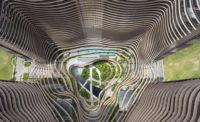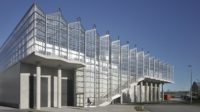Seattle, Washington
Built on an isthmus between Puget Sound and Lake Washington, Seattle boasts a history of fishing and nautical trade. Even today, Seattleites love their lakes and waterways, and many go to work each day by ferry. On Lake Union, just north of downtown, in the residential Eastlake district, Susan Jones, FAIA, of atelierjones, converted an old fishing-industry warehouse, resting on ancient piers and steeped in the city’s history, into an upscale 20,000-square-foot office building to which occupants can commute by kayak.
For 100 years, the property had housed the family-owned Wards Cove Packing Company with its fish-packing and boat-repair facilities supporting a fleet working out of Ketchikan, Alaska. But to enhance the value of its waterfront property, the family decided to clean up the site’s industrial conditions and repurpose one of the two warehouses. Jones, whose Seattle-based firm specializes in sustainable urban housing, saw the project as a plum job. “It was a big, old, ugly warehouse,” she recalls, “but we’re always looking for underused sites to tackle.”
Program
The client, the Brindle family, wanted its existing 80-year-old office building to remain, with only a few cosmetic changes. A master plan developed by NBBJ called for demolishing one of two warehouses on the site to provide parking and converting the other to a two-story, class-A office building. The program also included a kayak access path, the development of an 11-slip marina for large yachts, and 12 slips and design guidelines for houseboats. Behind many of the family’s decisions was its desire to preserve a relationship between the property, the lake, and the family’s history. Meanwhile, the permitting review process triggered a state Department of Ecology mandate to clean up the lakeshore.
Solution
Renovating the long, narrow warehouse fronting the lake, atelierjones converted industrial spaces downstairs into offices, restrooms with showers, a fitness room, visitors’ quarters for overnight stays, and storage rooms sized to accommodate kayaks. The firm turned the second floor into an airy, open office space, with exposed HVAC and structure. Taking advantage of the site’s most attractive amenity — the lake itself — Jones increased the size and number of windows to maximize views to the water. She also extended the ground floor outdoors by building a deck of cumuru — a hard wood that lays flat — for tenant use in pleasant weather.
Jones played with history at every turn. Removing most of the nonstructural elements, she chose finish materials — natural-wood-composite paneling, galvanized steel, corrugated metal — whose patina and textures recall the former warehouse and the fishing fleet. She reclaimed heavy timbers from the demolished warehouse for benches and other site furniture. She worked with artist Buster Simpson to craft fences that recall the construction drawings of a favorite Brindle family vessel. And she created a “memory lane” hallway on the ground floor dedicated to fishing-industry-related artwork and old photos of family and boats. The central”grand” stair, with its recycled wood and galvanized steel, evokes nautical vessels and attracts far more traffic than the mandated elevator.
Although the owners chose not to pursue LEED certification, Jones emphasized sustainability in her design. She reused the existing building’s floor and structure and some material from the adjacent demolition. She specified occupancy sensors for lighting controls, materials with recycled content, low-flow plumbing fixtures, low- and no-VOC paints, and high-efficiency lighting.
Conveniently, the existing warehouse was 60 feet wide, ideal for enabling daylight to penetrate to the core of the open office space. Jones specified operable windows to facilitate natural ventilation, though she was obliged to also provide mechanical cooling. Between the two office buildings, she designed a courtyard featuring a bioswale of native plants and crushed lava to manage runoff. In front of the refurbished building, workers pulled industrial debris from the lake as part of the remediation effort.
The small office building now houses five tenants, all of whom finished their own spaces. The entire second floor is home to an environmental consulting firm. Downstairs are two architects, a marine engineer, and a development company.
Commentary
Although Wards Cove is a few miles from downtown, it competes successfully with more centrally located office buildings. Astonishingly, in the economic climate of 2010, the leases were snatched up in less than a year, despite higher rents ($23.50 per square foot) than downtown, where occupancy has dropped to 80 percent and top-floor penthouses can be found for $18 per square foot. One tenant, commenting on the unique location, calls the lake view “calming and inspiring.” In Wards Cove, Jones has successfully combined a modern sensibility informed by history with Seattleites’ love of the water.
Completion Date: February 2009
Gross square footage: 19,850 sq.ft.
Total construction cost: $3.8 million
Owner: Wards Cove Packing Company
Architect:
atelierjones
911 Western Ave. Suite 440
Seattle, WA 98104,
phone: 206.624.9966
fax: 206.624.9957
People
Owner
Architect
Personnel in architect's firm who should receive special credit:
Architect of record
Associate architect(s)
Interior designer
Engineer(s) Civil Engineering: Layton & Sell, Inc., Electrical Engineering: Gerber & Vail, Inc.,
Consultant(s) Lighting: atelierjones Acoustical: Sparling, Inc. Other: Buster Simpson, Artist
General contractor
Photographer(s)
Renderer(s) CAD system, project management, or other software used: AUTOCAD 2009 |
Products
Exterior Cladding Wood: PRODEMA Baq+, Color: Dark Brown
Windows
Doors Sliding doors: wooden doors, reclaimed from on-site demolition
Hardware
Interior Finishes
Floor and wall tile: Bedrock Recycled Glass
Lighting Exterior: ERCO Axis Walklight/LED Controls: Lutron, Wattstopper
Conveyance
Plumbing
Add any additional building components or special equipment that made a significant contribution to this project Site/Narrows Decking: Cumuru |








Post a comment to this article
Report Abusive Comment